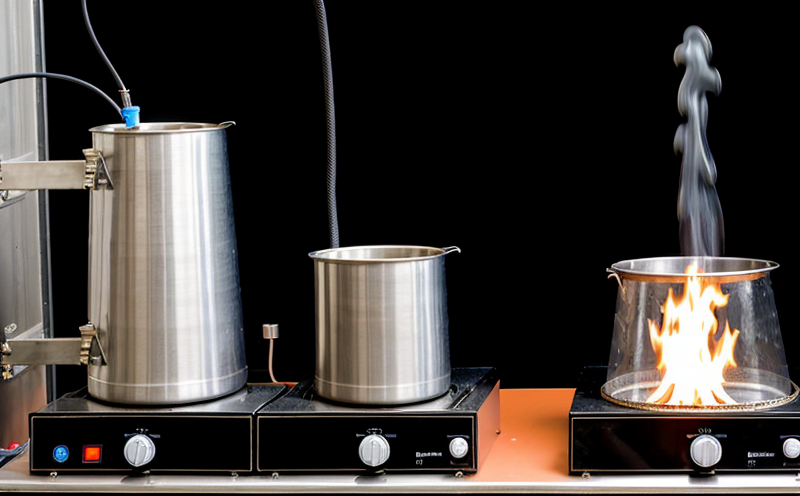Fire Performance Testing of Rubber with Calorimetry
In today’s world, fire safety is a critical concern across various sectors including construction, automotive, and consumer goods. Ensuring that materials used in these applications do not contribute to the spread of fire or pose significant risks when exposed to heat or flame requires rigorous testing. One such test involves heat release and calorimetry, which plays a pivotal role in assessing the fire performance of rubber products.
Rubber, due to its unique properties, is widely used in various applications ranging from automotive components to insulation materials for buildings. However, when exposed to high temperatures or flames, rubber can emit flammable gases that contribute to the spread of fire. Heat release calorimetry helps quantify these emissions and assesses how much heat a material generates during combustion.
The process involves subjecting a specimen of rubber to controlled heating in an oxygen-rich environment. The apparatus measures both the amount of heat released by the sample as well as the flammable gases it emits. This data is critical for manufacturers to ensure their products meet safety standards and contribute positively to fire safety.
At our laboratory, we offer comprehensive testing services that provide detailed insights into a rubber’s fire performance through calorimetry. Our team of experts uses advanced instrumentation and adheres strictly to international standards such as ISO 5660-1:2013 and ASTM E648-19. These tests not only evaluate the heat release but also ensure that the rubber specimen remains intact under specified conditions.
The results from these tests are invaluable for quality managers, compliance officers, R&D engineers, and procurement teams who need to make informed decisions about product safety and performance. By understanding exactly how much heat a rubber sample releases during combustion, manufacturers can design safer products and materials that comply with stringent regulations.
Applied Standards
The fire performance testing of rubber using calorimetry is governed by several international standards designed to ensure consistency and accuracy in test results. The most widely used standards include:
- ISO 5660-1:2013 – This standard specifies the procedure for determining the heat release rate of materials under controlled conditions.
- ASTM E648-19 – ASTM’s standard provides guidelines on measuring the total heat released during combustion, which is crucial in assessing fire safety properties of rubber specimens.
- EN 13823:2005 – This European standard deals with the determination of flammability and flame spread behavior of materials under controlled conditions. It complements ISO and ASTM standards by providing additional parameters for evaluation.
The compliance with these standards ensures that our testing results are reliable, repeatable, and internationally recognized. By adhering to these guidelines, we maintain the highest level of accuracy and precision in all our fire performance tests on rubber materials.
Scope and Methodology
| Test Parameter | Description | Standard |
|---|---|---|
| Heat Release Rate (HRR) | The amount of heat released per unit time during combustion. | ISO 5660-1:2013, ASTM E648-19 |
| Total Heat Released (THR) | The total heat energy released by the material over a specified period of exposure to fire. | ASTM E648-19, EN 13823:2005 |
| Flame Spread Index (FSI) | A measure of how quickly flames spread across the material's surface during testing. | EN 13823:2005, ASTM E648-19 |
| Smoke Production Rate (SPR) | The rate at which smoke is produced by the burning specimen. | ISO 5660-1:2013 |
In our testing process, we begin by selecting a representative sample of rubber material. This sample undergoes rigorous preparation to ensure it accurately reflects the properties of the finished product. Once prepared, the specimen is placed in an oxygen gas stream within a calorimeter. The apparatus then heats the sample, and sensors measure the heat release rate, total heat released, flame spread index, and smoke production rate.
The testing environment closely mimics real-world conditions to ensure that the results are relevant and applicable. After the test run, our team analyzes all data points collected during the process. The final report includes detailed metrics on each parameter measured along with compliance status relative to specified standards.
Use Cases and Application Examples
The fire performance testing of rubber using calorimetry is particularly important for industries where material integrity under extreme heat conditions is crucial. Here are some key areas where this service finds application:
Automotive Industry: Rubber seals, hoses, and belts used in vehicles must withstand high temperatures without compromising safety or function. Calorimetric testing ensures that these components do not release harmful gases during a fire.
Building and Construction: Insulation materials often made from rubber are tested to ensure they remain stable under extreme heat conditions, thus preventing the spread of fire through walls and ceilings.
Consumer Goods: Rubber components in toys or household items must meet stringent safety requirements. Calorimetry helps manufacturers verify that their products won't contribute to a hazardous environment during accidental fires.
Our laboratory’s expertise ensures that every test conducted aligns with the specific needs of each industry, providing valuable insights into material behavior under fire exposure conditions.





